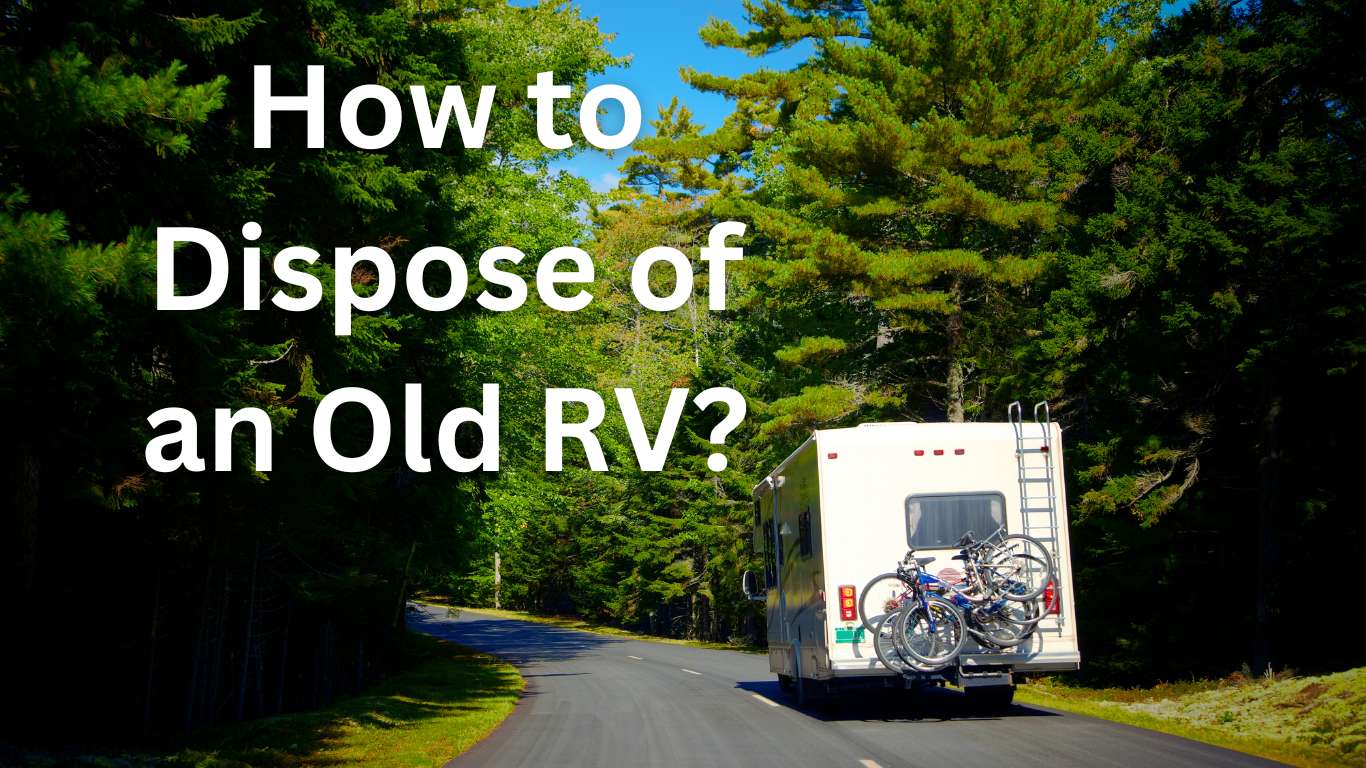Owning an RV is exciting, but when it reaches the end of its life, disposing of it can seem challenging. Don’t worry—this guide will show you how to dispose of an old RV in an eco-friendly, cost-effective, and straightforward way.
Why Proper Disposal of an Old RV Matters
Disposing of an old RV is not just about getting rid of an unusable vehicle. It’s about protecting the environment, adhering to local regulations, and maximizing value through recycling or repurposing.
Factors That Force You to Dispose of an Old RV
At some point, every RV owner faces the tough decision of parting ways with their beloved recreational vehicle. But what drives this decision? Let’s explore the key factors that force you to dispose of an old RV and why it’s important to address them responsibly.
1. Extensive Wear and Tear
Over time, RVs experience significant wear and tear from frequent use and exposure to the elements. Issues like:
- Leaking roofs or windows,
- Structural damage,
- Deteriorated interiors,
can make repairs impractical or too expensive, forcing owners to consider disposal.
2. Engine or Mechanical Failure
When an RV’s engine or major mechanical systems fail, repairs may cost more than the RV’s value. Problems like transmission issues, brake system failure, or outdated parts often push owners toward recycling or trading in their RV.
3. Rising Maintenance Costs
Older RVs demand frequent repairs and maintenance, which can quickly add up. From plumbing leaks to electrical failures, these ongoing expenses may outweigh the benefits of keeping the vehicle.
4. Outdated Features
RVs with outdated technology or layouts may no longer meet modern needs. Lack of essential amenities, inefficient energy systems, or outdated designs can make an older RV less appealing and practical for current lifestyles.
5. Safety Concerns
Structural instability, faulty wiring, or compromised brakes can make an old RV unsafe for use. When safety becomes a concern, disposing of the RV is often the most responsible choice to prevent accidents.
6. Change in Lifestyle or Travel Preferences
Life changes, such as downsizing or shifting to newer RV models, can render older vehicles unnecessary. If an RV no longer fits your needs, it may be time to let it go.
7. Environmental Impact
Old RVs are less energy-efficient and produce more emissions compared to newer models. Concerns about their environmental footprint often motivate owners to upgrade to eco-friendly alternatives.
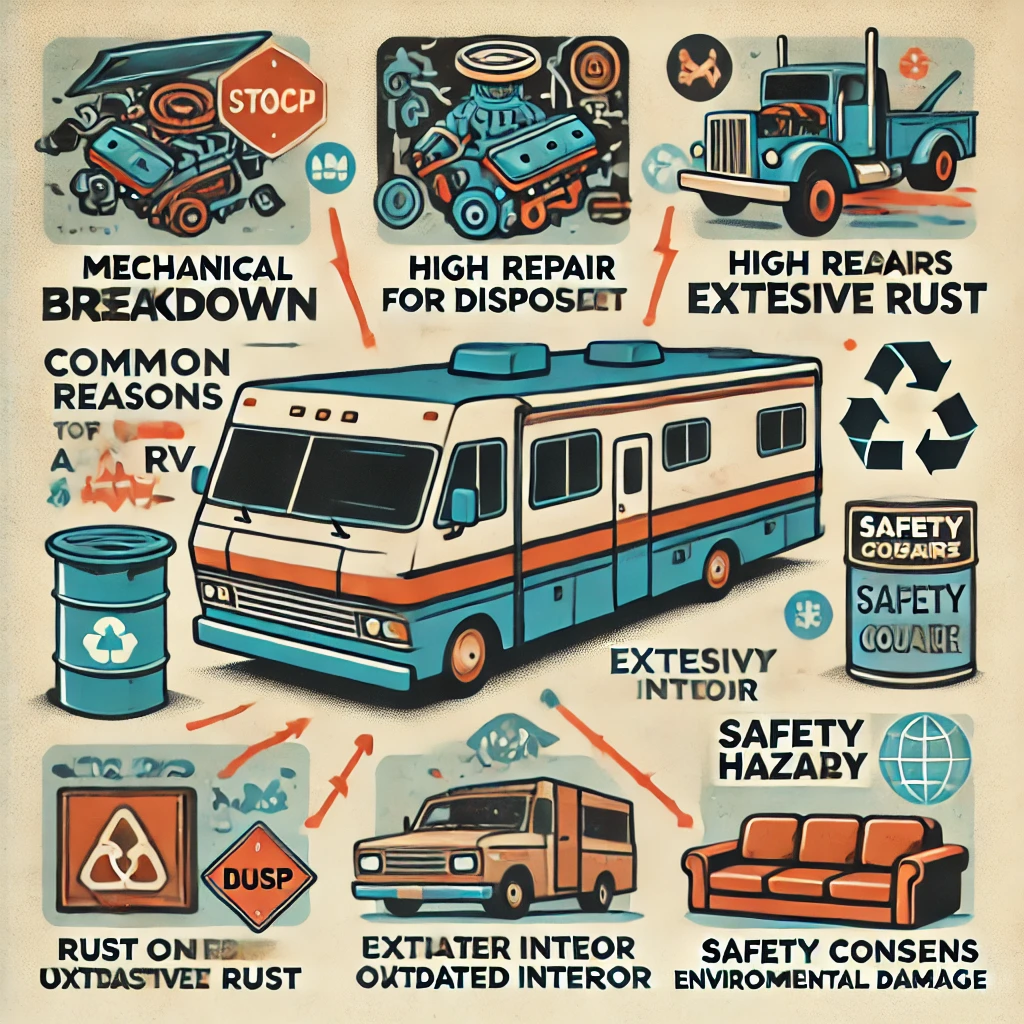
Methods to Dispose of an Old RV
When your RV has reached the end of its journey, disposing of it responsibly is essential. Whether it’s damaged, outdated, or no longer in use, here are the best methods to dispose of an old RV while considering cost, convenience, and environmental impact.
1. Sell Your RV to a Buyer
If your RV still holds some value, selling it can be a smart choice. You can list it on platforms like:
- Craigslist,
- Facebook Marketplace, or
- Dedicated RV sales websites.
Make sure to highlight its condition honestly and provide clear photos to attract potential buyers.
2. Trade It In at a Dealership
Many RV dealerships accept old RVs as trade-ins, even if they’re no longer in prime condition. This is an excellent option if you’re looking to upgrade to a newer model while saving on the purchase cost.
3. Donate It to a Charity
Nonprofit organizations often accept old RVs as donations. Some charities may even handle towing and repairs. This method can also offer tax benefits while helping a good cause.
4. Recycle It for Scrap Materials
If your RV is beyond repair, recycling is an environmentally friendly option. Scrap yards and recycling centers can:
- Extract valuable materials like aluminum, steel, and copper.
- Safely dispose of hazardous components like batteries and fluids.
5. Hire an RV Disposal Service
Professional RV disposal companies specialize in removing and dismantling old RVs. They take care of everything, including:
- Towing the RV from your property.
- Ensuring proper recycling of parts.
This hassle-free method is ideal for non-functional or heavily damaged vehicles.
6. Repurpose Your RV
For those who enjoy creative projects, repurposing an old RV can breathe new life into it. Turn it into:
- A stationary guesthouse.
- A backyard office.
- A storage unit.
This method reduces waste and gives your RV a unique new purpose.
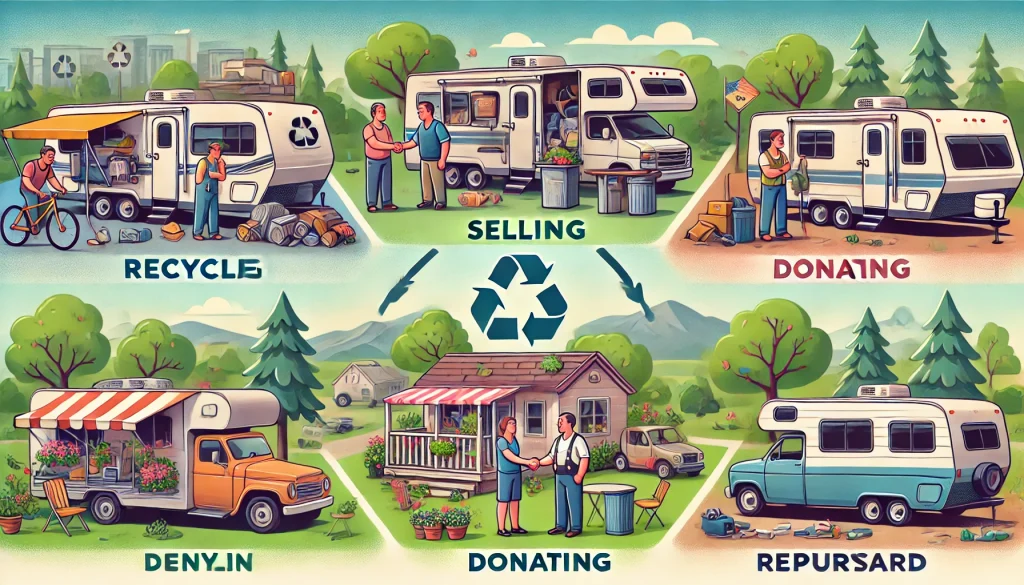
What to Consider Before Disposing of an Old RV
Check Local Regulations
Before disposing of your RV, research local laws regarding vehicle disposal and ensure compliance.
Remove Hazardous Materials
Components like propane tanks, batteries, and fluids must be disposed of properly to avoid environmental harm.
Document the Disposal
Whether selling, recycling, or donating, keep records for your peace of mind and tax purposes.
Essential Tools to Dispose of an Old RV
Disposing of an old RV may seem like a complex task, but having the right tools can make the process smoother and more efficient. Whether you’re dismantling it yourself or preparing it for recycling, these essential tools will help you handle the job responsibly and safely.
1. Heavy-Duty Cutting Tools
Breaking down an RV often involves cutting through metal, plastic, or fiberglass. Some of the best tools for this are:
- Angle grinders for cutting metal parts.
- Reciprocating saws for cutting through walls or frames.
- Bolt cutters to remove smaller metal fixtures.
2. Screwdrivers and Wrenches
For removing interior components like cabinets, furniture, and appliances, you’ll need:
- A set of Phillips and flathead screwdrivers.
- Socket wrenches for bolts and screws.
3. Safety Gear
Protecting yourself during the disposal process is crucial. Essential safety gear includes:
- Safety goggles to shield your eyes from debris.
- Heavy-duty gloves to prevent cuts and scrapes.
- Dust masks or respirators to avoid inhaling harmful particles.
4. Hydraulic Jacks or Lifts
Lifting the RV for easier access to its underside or wheels requires a hydraulic jack or vehicle lift. These tools are especially useful for recycling purposes.
5. Power Drill
A power drill makes quick work of removing screws, bolts, and fasteners. Attachments like drill bits and drivers will also be handy for dismantling various RV components.
6. Tarps and Storage Containers
When dismantling an RV, you’ll need tarps and containers to:
- Separate recyclable materials like metal, wood, and plastic.
- Store smaller parts for reuse or resale.
7. Fluid Extraction Tools
RVs contain hazardous fluids like oil, coolant, and propane. Use:
- Fluid pumps for safe removal of liquids.
- Proper containers to store and transport these fluids to disposal facilities.
8. Vehicle Towing Equipment
If you’re transporting the RV to a scrapyard or recycling center, you’ll need:
- Tow straps or a trailer hitch.
- A flatbed trailer for non-functional RVs.
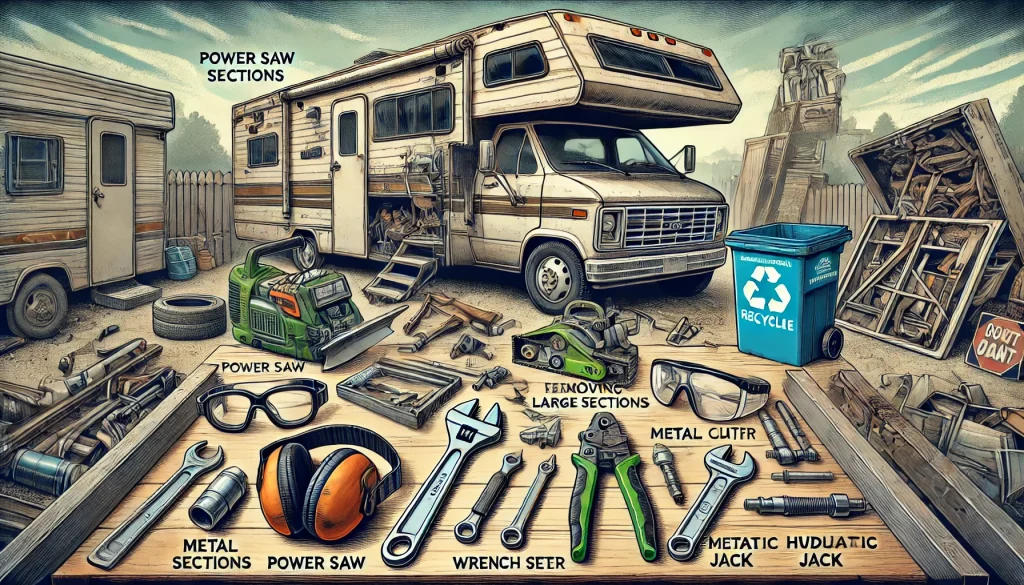
Bonus Tips for Efficient Disposal
Plan the Dismantling Process
Organize your tasks to start with removable interior parts before working on the frame and mechanical systems.
Work in a Well-Ventilated Area
RVs often contain chemicals and materials that release harmful fumes during dismantling. Ensure proper ventilation to protect your health.
Steps to Dispose of an Old RV
When it’s time to part with your RV, following a clear and responsible process is essential. Whether your RV is damaged, outdated, or no longer in use, these steps will guide you through the disposal process efficiently and with minimal hassle.
1. Assess the Condition of Your RV
Before deciding how to dispose of your RV, determine its condition:
- Is it operational?
- Can it be repaired?
- Does it have salvageable parts?
This assessment will help you choose the most suitable disposal method, such as selling, donating, or recycling.
2. Remove Personal Belongings
Take the time to thoroughly clean out your RV. Remove:
- Personal items.
- Documents and registration papers.
- Valuable components, such as electronics or furniture, that you can reuse or sell separately.
3. Decide on a Disposal Method
Based on the RV’s condition, select one of the following options:
- Sell it: If it’s still functional.
- Donate it: To a charity or nonprofit organization.
- Recycle it: At a scrapyard or recycling center.
- Hire a disposal service: For damaged or non-functional RVs.
4. Handle Hazardous Materials
Old RVs often contain hazardous substances, such as:
- Propane tanks.
- Batteries.
- Fluids like oil, coolant, or brake fluid.
Ensure these materials are properly removed and disposed of at designated facilities to avoid environmental damage.
5. Disconnect Utilities
Before towing or dismantling the RV, disconnect all utilities, including:
- Electrical systems.
- Plumbing and water connections.
- Propane lines.
This step ensures safety during transportation or dismantling.
6. Dismantle for Recyclable Parts (If Necessary)
If you’re recycling the RV, dismantle it to separate recyclable materials:
- Aluminum, steel, and copper.
- Appliances and fixtures.
- Tires and batteries.
Sort these components to maximize their recycling potential.
7. Arrange Transportation
For non-functional RVs, you may need towing services or a flatbed trailer to transport it to a scrapyard, donation site, or disposal facility.
8. Complete Documentation
Ensure all paperwork is in order before disposal:
- Cancel the RV’s registration and insurance.
- Transfer ownership if selling or donating.
- Obtain a receipt for recycling or disposal for legal and tax purposes.
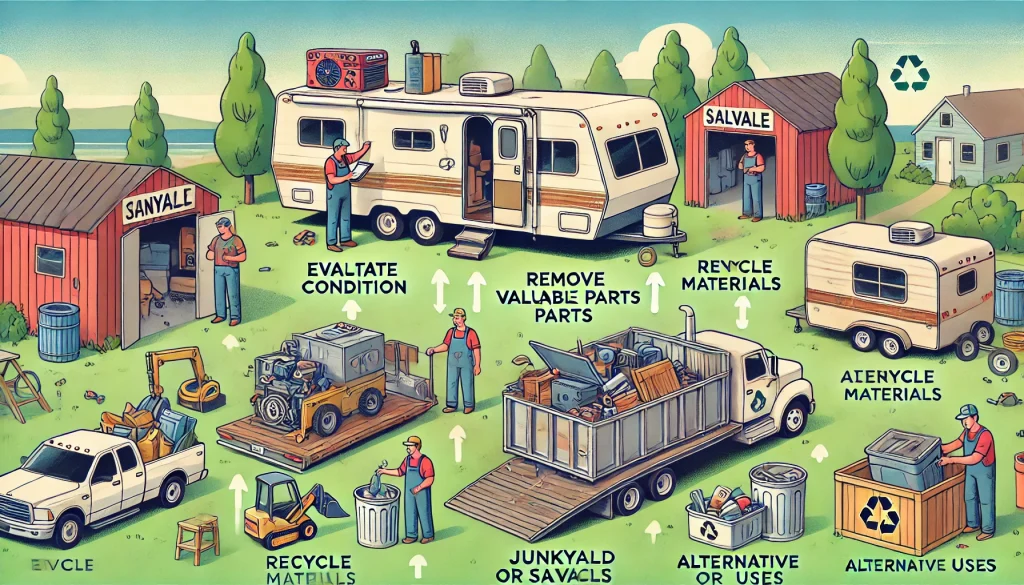
Do You Need a Professional to Dispose of an Old RV, or Can You Do It Yourself?
Disposing of an old RV can be a significant task, and deciding whether to hire a professional or handle it yourself depends on factors like the RV’s condition, your resources, and local regulations. Let’s explore both options to help you make the right choice.
When You Should Hire a Professional
Hiring a professional disposal service is often the best option if:
1. Your RV Is Beyond Repair
Non-functional RVs or those with severe structural damage may require specialized tools and expertise for dismantling or towing.
2. You Lack the Necessary Tools or Skills
Disposing of an RV involves cutting, dismantling, and safely handling hazardous materials like batteries and fluids. Professionals have:
- Heavy-duty tools.
- Knowledge of safe disposal practices.
- Experience managing large vehicles.
3. You Need Eco-Friendly Disposal
Professional services ensure all materials are recycled or disposed of responsibly, minimizing environmental impact.
4. You Face Time Constraints
If you don’t have the time to dismantle or transport the RV, a professional service can handle the entire process efficiently.
When You Can Dispose of an Old RV Yourself
Handling RV disposal yourself is possible if you have the time, tools, and ability to manage the process.
1. Your RV Is in Sellable Condition
If your RV still works or has valuable parts, you can:
- Sell it online.
- Donate it to a charity.
- Trade it in at a dealership.
2. You Have the Right Tools
Dismantling an RV requires equipment like:
- Power tools (saws, drills, etc.).
- Fluid pumps for hazardous materials.
- Safety gear for personal protection.
3. You’re Comfortable With Recycling Tasks
Recycling centers often accept dismantled RV components, including scrap metal, appliances, and tires. If you’re able to sort and transport these materials, DIY disposal can save money.
4. Local Laws Allow DIY Disposal
Check local regulations to ensure compliance. Some areas have restrictions on RV dismantling or require permits for disposing of large vehicles.
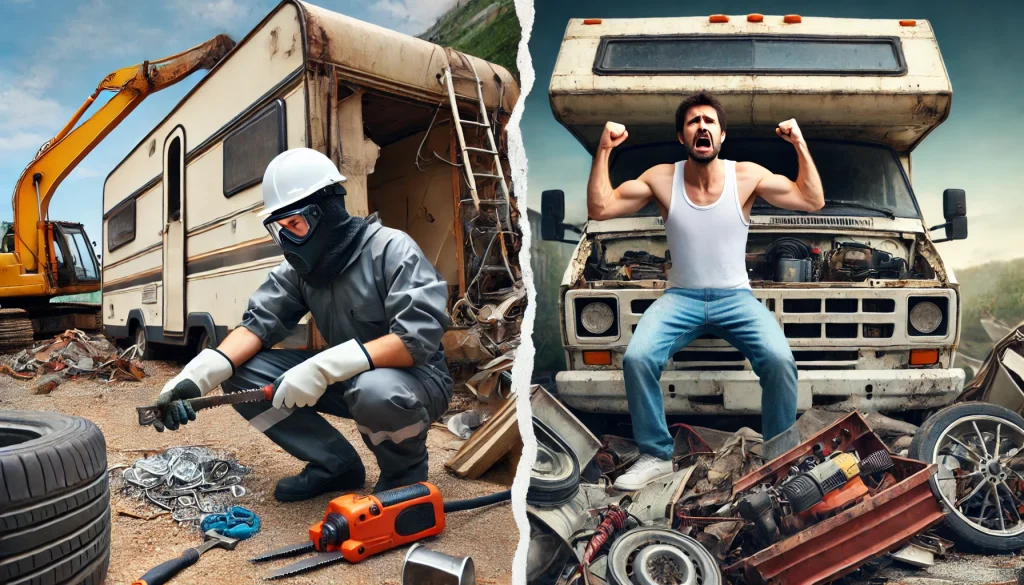
Common Mistakes When Disposing of an Old RV and Their Solutions
Disposing of an old RV can be a challenging task, and mistakes during the process can lead to unnecessary costs, legal issues, or environmental harm. Here’s a guide to the most common mistakes and how to avoid them for a smooth and responsible disposal process.
Mistake 1: Failing to Check Local Regulations
Problem: Many RV owners forget to review local laws on vehicle disposal. This oversight can result in fines or penalties for improper disposal.
Solution:
- Contact your local waste management authority to learn about regulations.
- Obtain any required permits if dismantling or recycling the RV yourself.
Mistake 2: Ignoring Hazardous Materials
Problem: RVs contain hazardous materials like propane, batteries, oil, and coolant. Mishandling these can harm the environment and pose safety risks.
Solution:
- Safely remove and dispose of hazardous materials at designated facilities.
- Consult a professional if unsure about handling these components.
Mistake 3: Not Maximizing Value from the RV
Problem: Owners often overlook opportunities to sell or recycle valuable components, losing potential income.
Solution:
- Salvage parts like appliances, furniture, and scrap metal before disposal.
- Sell functional parts online or to salvage yards for extra cash.
Mistake 4: Attempting DIY Without Proper Tools
Problem: Many owners underestimate the complexity of dismantling an RV, leading to injuries or damage.
Solution:
- Use appropriate tools like saws, drills, and safety gear.
- Hire a professional disposal service if you lack the tools or expertise.
Mistake 5: Forgetting to Cancel Registration and Insurance
Problem: Skipping this step can result in ongoing fees or complications when transferring ownership.
Solution:
- Contact your local Department of Motor Vehicles (DMV) to cancel the RV’s registration.
- Notify your insurance provider to stop coverage and avoid unnecessary payments.
Mistake 6: Improper Transportation of the RV
Problem: Transporting a non-functional RV without the right equipment can damage the vehicle or create safety hazards.
Solution:
- Use a flatbed trailer or towing service for non-drivable RVs.
- Ensure the RV is securely fastened during transport.
Mistake 7: Rushing the Process
Problem: Hastily disposing of an RV can lead to incomplete dismantling, overlooked materials, or missed recycling opportunities.
Solution:
- Plan the process step by step, starting with an assessment of the RV’s condition.
- Allocate sufficient time to dismantle and sort materials responsibly.
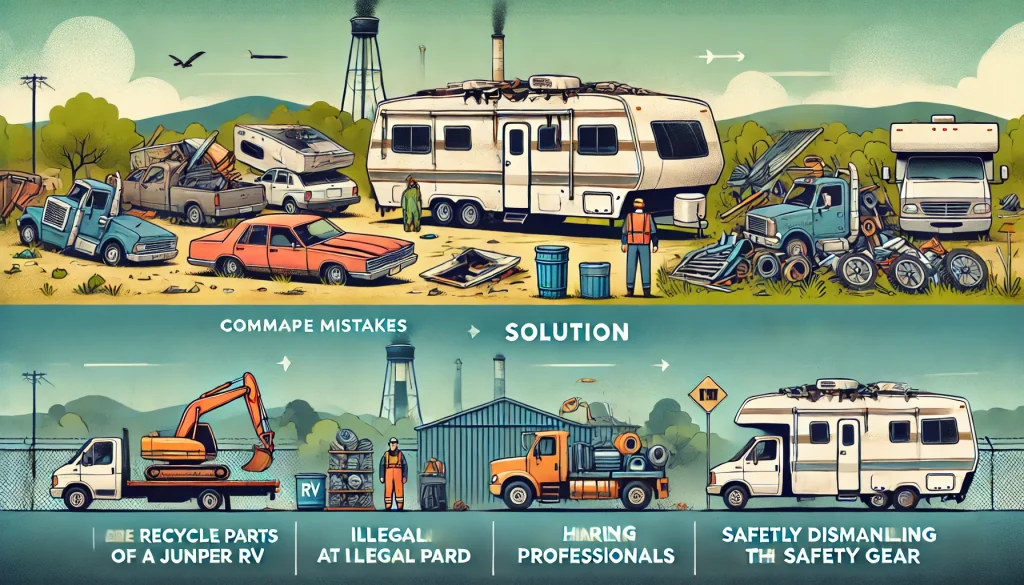
Safety Precautions to Dispose of an Old RV
Disposing of an old RV involves working with heavy materials, sharp tools, and hazardous components. Prioritizing safety throughout the process is essential to prevent injuries, legal issues, and environmental harm. Here are the key safety precautions to follow when disposing of your RV.
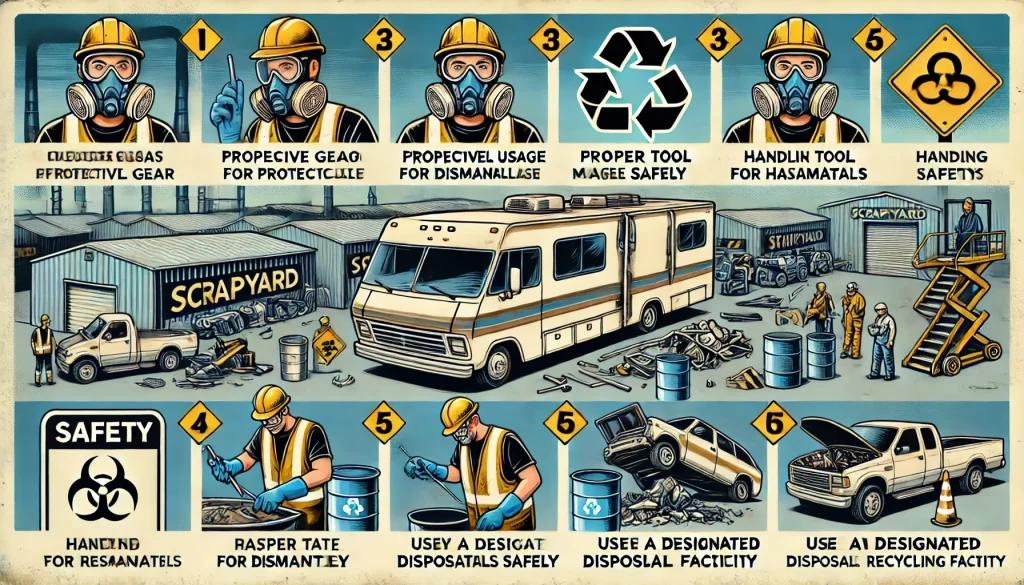
1. Wear Proper Safety Gear
Why It’s Important: Handling tools, sharp edges, and toxic materials can cause injuries.
What You Need:
- Safety goggles: Protect your eyes from flying debris.
- Heavy-duty gloves: Prevent cuts and scrapes.
- Steel-toed boots: Protect your feet from heavy falling objects.
- Dust mask or respirator: Avoid inhaling dust and fumes.
2. Remove Hazardous Materials Safely
Why It’s Important: RVs contain harmful substances like:
- Propane tanks
- Batteries
- Oil and coolant
Precautions:
- Disconnect propane tanks and store them away from heat sources.
- Drain fluids (oil, coolant, brake fluid) into approved containers.
- Recycle or dispose of hazardous materials at designated facilities.
3. Use the Right Tools
Why It’s Important: Improper tools can damage the RV or cause accidents.
Recommended Tools:
- Power tools like saws and drills for dismantling.
- Hydraulic jacks for lifting heavy sections.
- Bolt cutters for removing metal components.
4. Secure the Work Area
Why It’s Important: A cluttered or unsafe workspace increases the risk of accidents.
Precautions:
- Work in a well-lit, spacious area.
- Keep children and pets away from the site.
- Use tarps to catch debris and keep the area clean.
5. Handle Sharp and Heavy Components with Care
Why It’s Important: RV frames and parts can be sharp or extremely heavy.
Precautions:
- Always have a second person to assist with lifting heavy components.
- Use proper lifting techniques to avoid back injuries.
- Cover sharp edges with padding when moving parts.
6. Disconnect Utilities Before Starting
Why It’s Important: Remaining connected to electrical or plumbing systems can cause shocks or leaks.
Steps to Take:
- Disconnect the RV’s battery and electrical system.
- Shut off water lines and drain all tanks.
- Check for residual gas in propane lines.
7. Follow Local Disposal Regulations
Why It’s Important: Non-compliance with local laws can lead to fines or legal issues.
Precautions:
- Check local waste management guidelines for disposing of large vehicles.
- Obtain permits if required for dismantling or recycling.
- Use licensed recycling centers for proper material disposal.
8. Plan for Safe Transportation
Why It’s Important: Moving a non-functional RV can be risky without proper precautions.
Precautions:
- Use a flatbed trailer or hire a professional towing service.
- Secure the RV with straps to prevent shifting during transport.
- Check tire pressure if the RV will be towed.
More related info will be available at Flamingo Motorhomes.

